|
|
|
Sort Order |
|
|
|
Items / Page
|
|
|
|
|
|
|
| Srl | Item |
| 1 |
ID:
186600
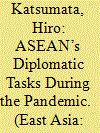

|
|
|
|
|
| Summary/Abstract |
What are the implications of COVID-19 for the diplomacy of the Association of Southeast Asian Nations (ASEAN)? What kinds of diplomatic tasks has the pandemic imposed on ASEAN, and in what way has the Southeast Asian association handled them? ASEAN’s most fundamental diplomatic task has of course been to continue building ASEAN communities, but the ability of the association of minor powers in Southeast Asia is limited. Hence, it can be said that ASEAN’s most important diplomatic task has been to maintain favorable relations with external powers, in particular, with China and the United States. The present study argues that ASEAN has managed to maintain favorable relations with and receive support from both of these external powers by conducting “equidistant diplomacy” with them. In concrete terms, it has fostered favorable relations with China. Yet, without relying excessively on Beijing, it made sure to foster such relations with the United States as well, thereby striking a reasonable balance between these two external powers.
|
|
|
|
|
|
|
|
|
|
|
|
|
|
|
|
| 2 |
ID:
116566


|
|
|
|
|
| Publication |
2012.
|
| Summary/Abstract |
The rise of China has brought forth new sets of opportunities and challenges for Southeast Asia. A new politico-strategic landscape has emerged in which, ASEAN not only seeks China's economic support perceived to be crucial for the development of the region, but also worries about China's growing power and the possibility of Chinese domination over the region. ASEAN as a regional interlocutor has responded to the new phenomenon by deploying a hedging strategy that seeks to benefit from the opportunities and manage the challenges emanating from the rise of China. While ASEAN's policy of 'honest brokerage' has allowed the presence of other powers to balance China, its policy of enmesh China has facilitated China's role as a stakeholder in the ASEAN cooperative processes.
|
|
|
|
|
|
|
|
|
|
|
|
|
|
|
|
| 3 |
ID:
137211
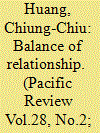

|
|
|
|
|
| Summary/Abstract |
Although many observers in the field of Southeast Asian international relations (IRs) predict that Myanmar's relations with China have faced a grand challenge since the 2010 presidential election, this article provides a different perspective and proposes that Myanmar's China policy remain consistent. In addition, theorists in IRs tend to apply the concepts of balance of power (BoP) and bandwagoning as the analytical base and fail to explain the Southeast Asian states’ responses to the rising China. This article argues that Myanmar's China policy is better understood and depicted by the theory of balance of relationship (BoR). This article further provides an analysis from the angles of historical factor, domestic political tradition, and external environment to investigate Myanmar's manipulation of BoR. The conclusion of this article aims at predicting the future development of the Sino-Burmese relations.
|
|
|
|
|
|
|
|
|
|
|
|
|
|
|
|
| 4 |
ID:
159414


|
|
|
|
|
| Summary/Abstract |
The foreign policy of Ceylon under the premiership of D.S. Senanayake maintained
a distinct alignment with its former coloniser Great Britain. The zenith
of this relationship was the defence agreement which came into effect upon
independence in 1948. Utilising the existing scholarship on neorealism and the
concept of security dilemma, analysis of the reasons behind this strategic alignment
exposes the threat perception Ceylon faced from its regional hegemon,
India. This study surveys such threat perceptions faced by the island at the time
of independence and argues that this led to a balancing strategy with Britain. It
first locates Ceylon’s foreign policy employing the taxonomies of balancing, bandwagoning
and hedging and then examines how Ceylon’s extra-regional alignment
with the UK enabled her to eschew from a security dilemma with India.
|
|
|
|
|
|
|
|
|
|
|
|
|
|
|
|
| 5 |
ID:
173190
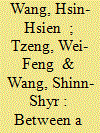

|
|
|
|
|
| Summary/Abstract |
In comparison to hegemony, lesser powers usually struggle for survival between two or more great powers under state power asymmetry, a perpetual phenomenon in international politics. With the rise of China and the increasingly strengthening role of the US in the Asia-Pacific region, it is important to learn how lesser powers manage their relations with the two. To explore this issue, we propose that the strength of state power will constrain the strategies of lesser powers as they choose between the US and China. Borrowing from existing theories and ideas on strategies that include balancing, bandwagoning, and hedging, we argue that the stronger a country’s power, the more likely it will choose a balancing strategy. At the same time, the weaker the country, the more likely that it will go with bandwagoning. Regional middle powers will show varied strategy choices, as they possess a higher degree of freedom in choosing which great power to side with. To validate these arguments, we construct two indicators — differences in trade dependence on the US and China and differences in the voting score consistent with the US and China — to quantify the strategies of lesser powers toward great powers and examine whether the variable of strategies follows the expected pattern. Our analysis shows that countries in the middle of the spectrum of state power demonstrated great freedom in choosing strategies toward the two powers.
|
|
|
|
|
|
|
|
|
|
|
|
|
|
|
|
| 6 |
ID:
180650
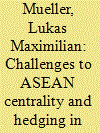

|
|
|
|
|
| Summary/Abstract |
Since 2010, ASEAN has made efforts to increase its coherence and visibility as an actor in regional infrastructure development, under the umbrella term of connectivity. Its most recent strategy, 2016’s Master Plan on ASEAN Connectivity 2025, is notable for its more focused agenda as well as a tableau of institutional innovations, including new policy coordination mechanisms and a project preparation pipeline. Nonetheless, ASEAN struggles to maintain coherence in the implementation of its connectivity agenda, both internally as well as towards its dialogue partners. Utilizing the concepts of centrality and hedging as parts of a unified theoretical framework, this paper analyzes ASEAN’s efforts to mobilize and manage external resources in connectivity. ASEAN’s resource dependence and its failure to establish institutional centrality creates issues at the regional and the national levels. Regionally, ASEAN’s lack of centrality and its perpetuation of ASEAN+1 relations have contributed to the emergence of contesting agendas and institutional frameworks by external actors. Nationally, the hedging strategies of ASEAN member states are at odds with the regional vision, highlighting a lack of intra-ASEAN coherence. The perpetuation of contesting institutional frameworks by external actors at the national level solidifies existing incoherence in ASEAN’s connectivity governance, further undermining its centrality. ASEAN’s efforts to assert centrality and execute a hedging strategy in connectivity are emblematic of its attempts to extend its reach into new policy areas, but also of its persistent governance constraints.
|
|
|
|
|
|
|
|
|
|
|
|
|
|
|
|
| 7 |
ID:
113973
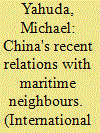

|
|
|
|
|
| Publication |
2012.
|
| Summary/Abstract |
Chinese maritime assertiveness since 2008 is a product of China's growing economic and military power combined with a centrally fostered nationalism. Although incidents with several maritime neighbours may not have all been initiated by China, the Chinese over-reacted. Matters were made worse by the opacity of Chinese decision-making processes and by problems of governance as shown by the multiplicity of Chinese authorities in charge of separate naval forces. The American 'pivot' to Asia provides neighbours with a hedge against an overbearing China, but they still need to cultivate relations with China on whom they are economically dependent.
|
|
|
|
|
|
|
|
|
|
|
|
|
|
|
|
| 8 |
ID:
163754
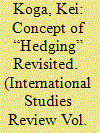

|
|
|
|
|
| Summary/Abstract |
This article argues that the concept of “hedging” should be understood in the context of the “balancing-bandwagoning” spectrum within the “balance of power” theory, in which hedging is located between balancing and bandwagoning as the state's third strategic choice. Although polarity— unipolar, bipolar, and multipolar—largely determines the likelihood of hedging behavior, during a period of power shift, strategic uncertainty emerges. States, particularly secondary powers, attempt to calculate the risk of balancing, bandwagoning, and hedging, adopting an optimal strategy. To identify states’ strategic behavior, it is important to first examine their economic and military capabilities, and if these indicators are not decisive enough to identify balancing, bandwagoning, or hedging behavior, diplomatic factors should be taken into account, although those are a relatively weaker indicator.
The use of this conceptual framework reveals that Japan's foreign policy behavior has not involved “hedging” vis-à-vis China; instead, Japan's behavior is consistently associated with “balancing” against the risks of China's rise. In addition, while Japan's behavior vis-à-vis the United States is considered to be bandwagoning, Japan made political efforts to strengthen its own military capabilities—internal balancing—which began in the 2010s when Japan relaxed its political constraints on use of its military. This behavior also aimed both to illustrate Japan's efforts related to alliance burden-sharing and to enhance its external balancing with the United States. Yet, the periods from 1997 to 2005 and from 2010 on represent an aberration because Japan engaged one type of hedging—security hedging—vis-à-vis the risk of US commitment reduction to East Asia. In this sense, while concurring with the realists’ argument that Japan's current behavior is characterized as balancing, the argument differs from that of realists who believe that Japan's policy shift to balancing toward China only began with China's rise in the late 2000s or 2010s.
|
|
|
|
|
|
|
|
|
|
|
|
|
|
|
|
| 9 |
ID:
192074
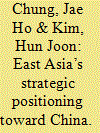

|
|
|
|
|
| Summary/Abstract |
Relatively few systematic and categorical studies have been conducted on the variant responses by East Asian states to the rise of China, and even fewer dealt with reasons for such intra-regional variations. This study seeks to fill the void by examining the strategic responses by 15 East Asian states for the period of 2011–2016. This period merits close scrutiny because China became more explicitly assertive. The research proceeds in two phases. First, by way of reading into the expert assessments in academic journals, the strategic responses of the 15 states are categorised into balancing, hedging, or bandwagoning. Second, statistical analyses are conducted to see how the intra-regional variations are related to unit-level factors. Of the seven variables analyzed, three – geographical proximity, democracy, and identity – turn out to be crucial in determining the East Asian states’ strategic responses.
|
|
|
|
|
|
|
|
|
|
|
|
|
|
|
|
| 10 |
ID:
174405
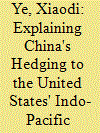

|
|
|
|
|
| Summary/Abstract |
How China responds to the United States' Indo-Pacific strategy has become a crucial question for both policymakers and academics. The existing literature primarily focuses on how and why the United States, Japan, Australia, and India have promoted the Indo-Pacific concept and how this concept has imposed strategic pressure on China's national security. However, China's changing and complex attitudes and strategic responses to the Indo-Pacific concept have largely been overlooked. This article analyzes China's response from the perspective of a hedging strategy. It argues that while confronting the expanding range of containment, which is the crux of the Indo-Pacific strategy, China has applied a hedging strategy from two interrelated perspectives. In responding to the United States, the Chinese government adheres to the nonalliance principle and upgrades its China-Russia strategic partnership to resist the security pressure produced by the Indo-Pacific strategy. In responding to peripheral countries, China has adopted a reassurance approach to create a cooperative incentive for peripheral countries, particularly those that have security relations with the United States.
|
|
|
|
|
|
|
|
|
|
|
|
|
|
|
|
| 11 |
ID:
096721
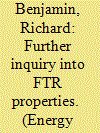

|
|
|
|
|
| Publication |
2010.
|
| Summary/Abstract |
William Hogan introduced financial transmission rights as a tool to hedge the locational risk inherent in locational marginal prices. FTRs are claimed to serve four main purposes: (1) provide a hedge for nodal price differences, (2) provide revenue sufficiency for contracts for differences, (3) distribute the merchandizing surplus an RTO accrues in market operations, and (4) provide a price signal for transmission and generation developers. This paper examines the hedging and redistributional properties of FTRs. It argues that FTR allocation has important distributional impacts and related implications for retail rates. This observation adds an additional explanation for rate increases in light of decreased production costs due to restructuring. This paper also shows that RTO practices have important implications for the hedging characteristics of FTRs. It further shows, via counterexample, that, even in theory, FTRs may not serve as a perfect hedge against congestion charges. The paper concludes with a series of recommendations for FTR allocation and the functions that FTRs should serve.
|
|
|
|
|
|
|
|
|
|
|
|
|
|
|
|
| 12 |
ID:
097514
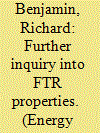

|
|
|
|
|
| Publication |
2010.
|
| Summary/Abstract |
William Hogan introduced financial transmission rights as a tool to hedge the locational risk inherent in locational marginal prices. FTRs are claimed to serve four main purposes: (1) provide a hedge for nodal price differences, (2) provide revenue sufficiency for contracts for differences, (3) distribute the merchandizing surplus an RTO accrues in market operations, and (4) provide a price signal for transmission and generation developers. This paper examines the hedging and redistributional properties of FTRs. It argues that FTR allocation has important distributional impacts and related implications for retail rates. This observation adds an additional explanation for rate increases in light of decreased production costs due to restructuring. This paper also shows that RTO practices have important implications for the hedging characteristics of FTRs. It further shows, via counterexample, that, even in theory, FTRs may not serve as a perfect hedge against congestion charges. The paper concludes with a series of recommendations for FTR allocation and the functions that FTRs should serve.
|
|
|
|
|
|
|
|
|
|
|
|
|
|
|
|
| 13 |
ID:
104056


|
|
|
|
|
| Publication |
2011.
|
| Summary/Abstract |
This article examines how geopolitical shifts and the potential emergence of either a bipolar or multipolar system will affect the transatlantic relationship and a small state on the margins of power centres. A more Asia-centred world and a new polarity could drive a wedge into the transatlantic relationship. It is therefore explored how the US and the EU can develop hedging and risk management strategies that are complementary and take into account diverging capabilities, political structures, different threat perceptions of China and the effects of a potential new polarity. It is also noted that Norway will need a sophisticated foreign policy if it wants to approach the EU's position related to China, while simultaneously sustaining close relations with a US that is becoming more preoccupied with China and continues to shift more of its resources towards Asia. A hedging strategy can guide Norwegian policy-makers to meet such challenges.
|
|
|
|
|
|
|
|
|
|
|
|
|
|
|
|
| 14 |
ID:
183127


|
|
|
|
|
| Summary/Abstract |
This paper surveys normative and positive arguments on why oil and gas exporting countries, in particular OPEC members, may expand into downstream industries (e.g. refining, petrochemicals), instead of exporting raw materials. Indeed, local refining can serve as a partial hedge against the vagaries of the oil price. Furthermore, as downstream activities require more complex tasks, the potential to provide economy wide spillovers, thereby fostering overall economic development will be generated. Major explanations including price differentiation (e.g., export taxes), industrial organization (e.g., property rights), efficiency (e.g., vertical integration), local development and spillover effects (e.g., on comparative advantage), risk hedging, climate change, and finally, political economy (e.g., lobbying and empire building) are surveyed from normative and positive aspects, which are then tested against facts. We also highlight the fact that all of those justifications are only efficient if political considerations are put aside. Policies such as granting the national oil companies a monopoly and by very large subsidies on refined products may indeed hinder achieving some of those goals.
|
|
|
|
|
|
|
|
|
|
|
|
|
|
|
|
| 15 |
ID:
123108


|
|
|
|
|
| Publication |
2013.
|
| Summary/Abstract |
In the face of a rising China, some scholars have argued that ASEAN countries will choose to either bandwagon with or balance against China, while others believe they will respond with a more moderate policy known as 'hedging'. In considering these options, ASEAN countries must take into account their individual interests within the economic and security structure of this region. In this research, we argue that each ASEAN country confronts divergent sets of security and economic relations with China, which play a major role in shaping their policy responses. We can characterize their responses into four quadrants. Each cell can be categorized in terms of a high or low degree of threat perception (HT or LT) from China, as well as a positive or negative economic expectation (PE or NE) with China. We thus hypothesize that ASEAN countries in the HT-NE situation will balance against China; those in the LT-PE situation will bandwagon with China; those in the HT-PE or LT-NE situations will hedge against China. Hypotheses are supported by three case studies, Vietnam-China (HT-NE), Cambodia-China (LT-PE) and Singapore-China (HT-PE) relations.
|
|
|
|
|
|
|
|
|
|
|
|
|
|
|
|
| 16 |
ID:
141146


|
|
|
|
|
| Summary/Abstract |
This article, hence, aims to explore the nature and patters of this ongoing process of strategic repositioning put into practice by Myanmar within the political triangle with Washington and Beijing. Against this backdrop, we will draw upon the conceptualization of ‘hedging strategy’, which identifies a set of multidimensional ‘insurance policies’ adopted by small actors in their relations vis-à-vis great powers.
|
|
|
|
|
|
|
|
|
|
|
|
|
|
|
|
| 17 |
ID:
186116
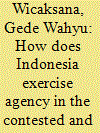

|
|
|
|
|
| Summary/Abstract |
Recent developments in the Asia-Pacific or Indo-Pacific region have illustrated the emergence of a contested region and unfolding regional order. Within the multiplicity, as argued in the introduction of the special issue, all stakeholders, including the weak state actors, not necessarily the superior ones, are participating in the process of order-building. This article looks at how Indonesia, the largest member country of ASEAN, pursues its agency amid the contested regional formulations between China and the US. The argument is that Indonesia promotes its concept of a rules-based interaction beyond the dominant great power politics, as a potential agency enabling the creation of a pluralised regional order. This agential position provides the basis to rethink the relevance of the established conceptual framework of hedging commonly used to understand small and middle powers’ foreign policies toward the major players. The author sees that Indonesia hedges in different ways, demonstrating a distinct conceptualisation which is likely to make a contribution to the project of Global IR.
|
|
|
|
|
|
|
|
|
|
|
|
|
|
|
|
| 18 |
ID:
151440
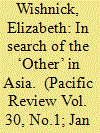

|
|
|
|
|
| Summary/Abstract |
This paper argues that Russia and China are partners of consequence and that the neglect of the normative dimension of the Sino-Russian relationship has led its impact on global governance to be undervalued and misunderstood. Following a constructivist approach, the paper examines the shared norms underlying an ever closer Sino-Russian partnership, despite divergent interests in a number of areas. A first section examines how shared norms lead Russia and China to define their identity similarly, facilitate joint actions, and constrain their individual policy choices. For Russia, elaborating its own unique identity is crucial to its claim to global status, though complicated by interactions with multiple ‘Others.’ Russia's effort to engage Asian partners is often viewed as hedging against China, but as second section argues that Russian engagement in Asia is better understood in terms of Russia's effort to define an Asian identity. A third section highlights the securitization/desecuritization dynamic in Sino-Russian economic relations. Xi Jinping's efforts to redefine China's global role reinforces its tendency to desecuritize the vulnerabilities that lead China to seek economic cooperation with Russia. Russia, fearing becoming a ‘resource appendage’ of China, then securitizes economic relations with China.
|
|
|
|
|
|
|
|
|
|
|
|
|
|
|
|
| 19 |
ID:
188451
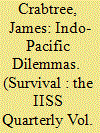

|
|
|
|
|
| Summary/Abstract |
The United States intends to manage China’s rise by forging a new balancing coalition of ‘like-minded’ partners and by developing deeper ties with other nations in the Indo-Pacific that view themselves as broadly non-aligned. Washington hopes that closer ties to the US and its partners will stop such countries from drifting towards China. But to create these deeper relationships, the non-aligned group also needs reassurance that attempts by the like-minded partners to integrate capabilities and fashion a new regional balance of power will not tip the Indo-Pacific towards conflict. Like-minded nations will need to appreciate the risks that security initiatives like the Quad and AUKUS are perceived to create, realise that Hanoi or Jakarta is unlikely to embrace Canberra’s or Tokyo’s vision of the region’s future warmly, and be willing to make substantial material investments. Tension between integration and reassurance will inevitably endure.
|
|
|
|
|
|
|
|
|
|
|
|
|
|
|
|
| 20 |
ID:
188167


|
|
|
|
|
| Summary/Abstract |
Whereas Japan’s hedging vis-à-vis China in the Indo-Pacific has predominantly been the focus of academic analysis, hedging also explains Tokyo’s policy choices in the Gulf to a significant degree. Yet, existing literature has largely overlooked Japan’s hedging behaviour in the Gulf, which had to navigate the uncertainties generated by two competing powers, the United States and Iran. As hedging theory is above all concerned with risk, Japan’s policies demonstrate a concern with managing risks and the adverse consequences of misalignment or alignment. Tokyo’s attempts to serve as what former Foreign Minister Kono Taro called an “honest broker”, however, have not enabled it to shape the evolving regional security architecture. Japan’s propensity to deploy hedging more effectively in the Gulf may be shaped by domestic political considerations, pressing security challenges closer to home and personalities of key Japanese politicians such as late former Prime Minister Abe Shinzo.
|
|
|
|
|
|
|
|
|
|
|
|
|
|
|
|
|
|
|
|
|